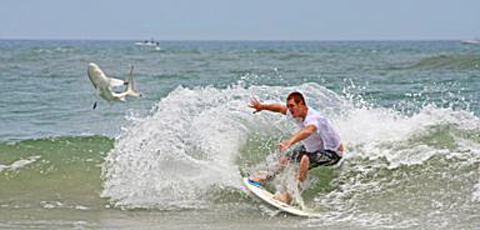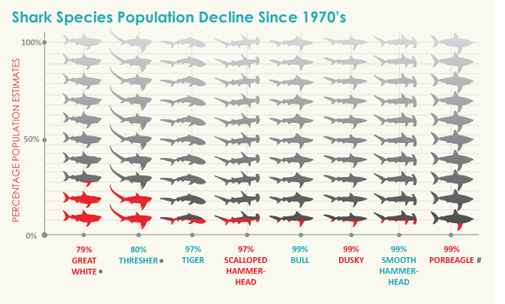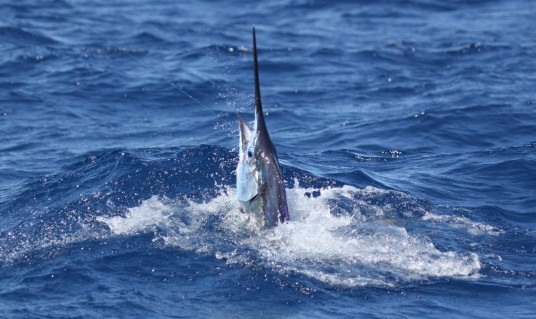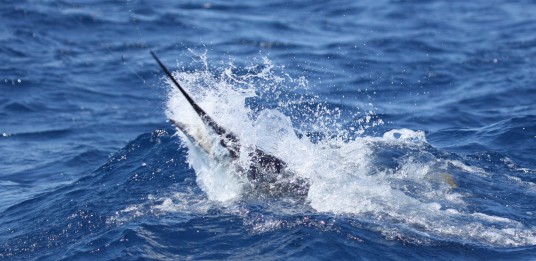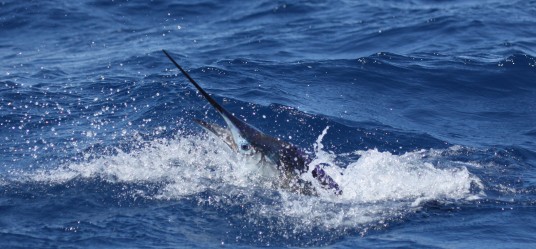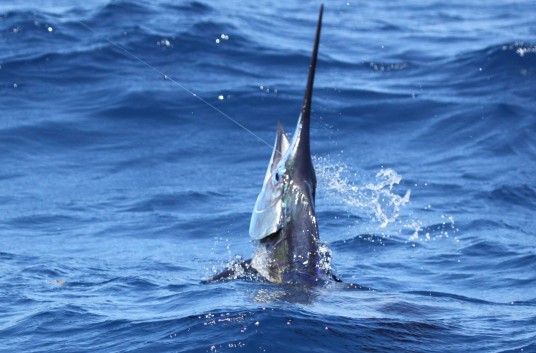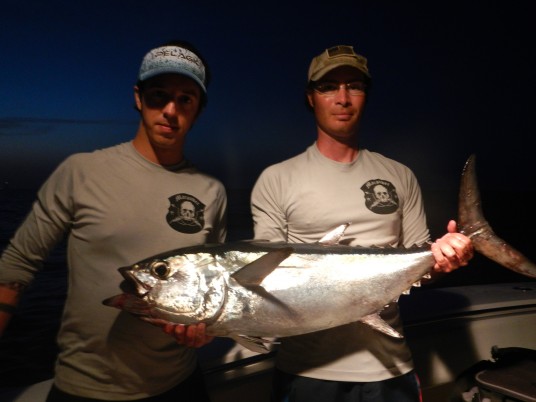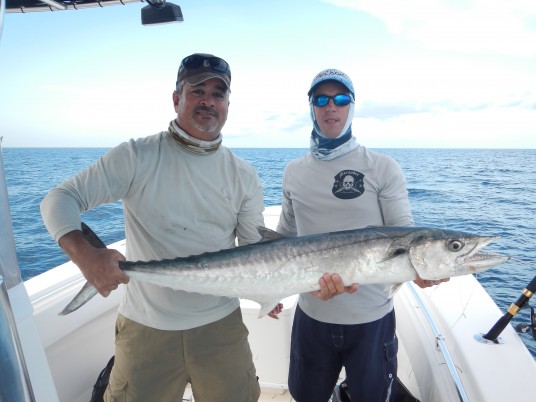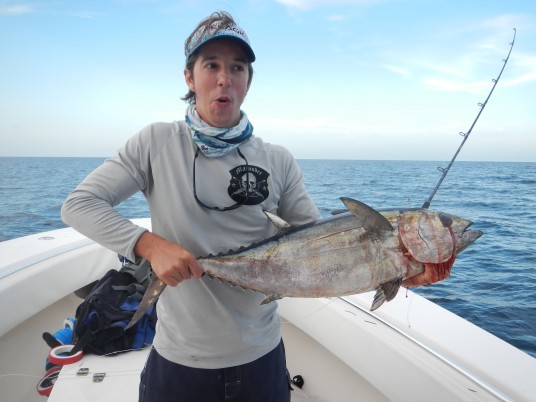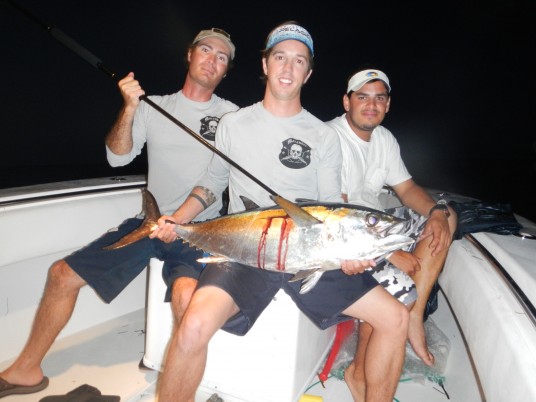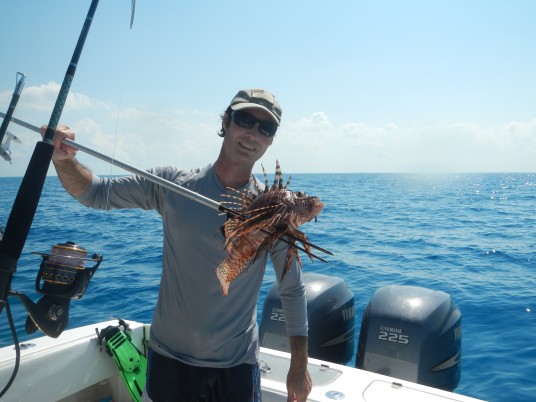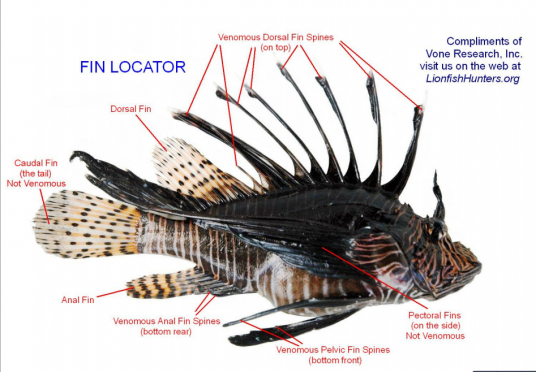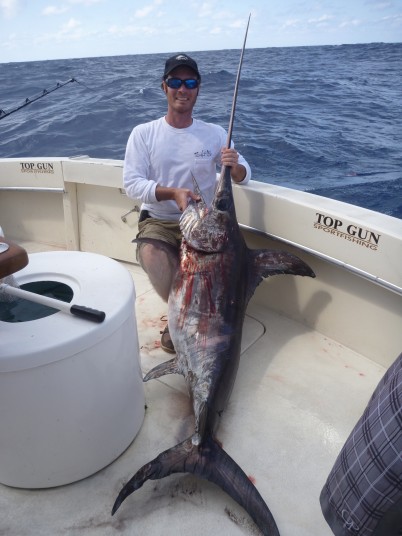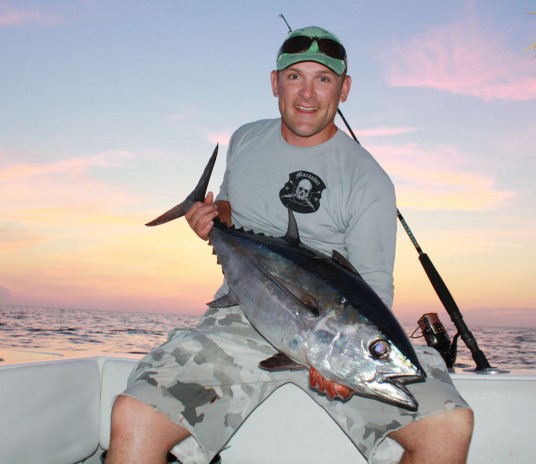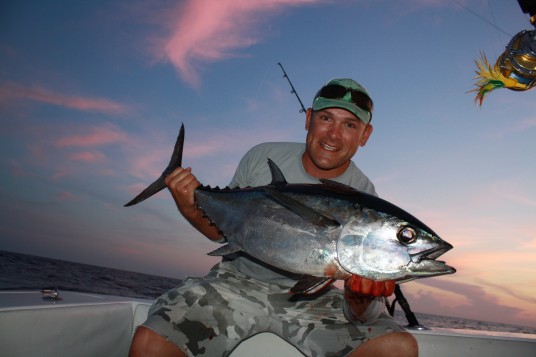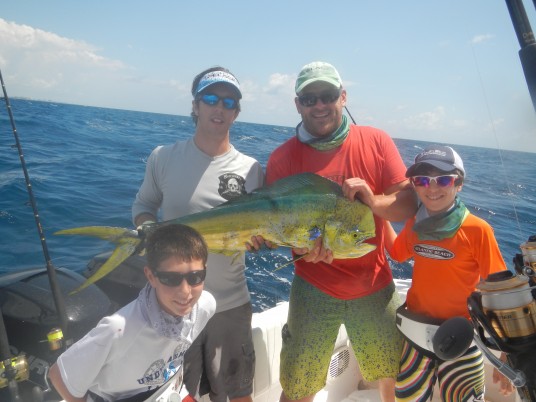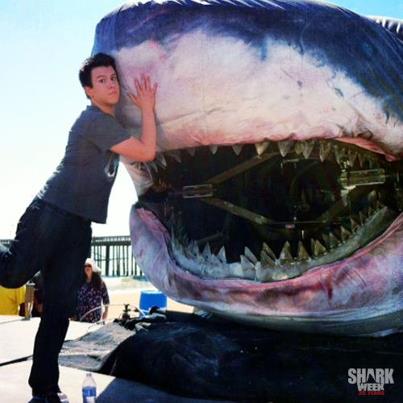
Selachophobia – the fear of sharks. Personally – I just have a phobia of the Jaws theme music. Everyone is still afraid of the John Williams epic theme. It still scares the crap out of me whenever I get in the ocean, and I’m pretty sure it has ruined the ocean for generations of potential swimmers, snorkelers, divers, and surfers. I know it’s not logical, but I’m STILL afraid for my life for at least a few minutes whenever I jump in the ocean, and hear that horrible Bump Bump…Bump Bump…bumpumpupupum in my ear. Terror often trumps logic, and many people hold this very same illogical fear fueled by gory images of teeth and flesh that make great (although very rare) news flashing through their mind when they jump into the deep blue sea.
If you’re LUCKY enough to see a big shark in the water – smart money says more people would die from the heart attack, than from being bitten by the shark. If you want to see a shark in the wild, try Field School shark research, or check out the shark tagging project at OCEARCH.
Chances are you’re going to die doing something MUCH less excited than getting eaten by Air Jaws Apocalypse. The stats may shock you more than the top 10 shark bite videos when you start crunching the numbers – or at least demonstrate why you should be much more afraid of some other every day things. Don’t sacrifice swimming in the our awesome oceans to a fear based in fiction. These apex predators are beautiful in the wild, and not the villains of horror movies.
In 2003 there were 4 fatal shark attacks worldwide. In contrast, in the US alone the same year:
- 26 people died as a result of contact with hot tap water
- 31 people were killed by pet dogs
- 47 people were struck by lightning,
- and 5,472 died due to intentional self-poisoning – source
It’s almost the 25th anniversy of shark week! Every year millions of shark lovers tune in to the Discovery Channel to see the year’s greatest shows about shark exploration and examination. Watching someone feed a shark is a bit like watching evil kenieval take a jump, even if you’re concerned about safety it’s pretty exciting and hard to look away.
I love shark week, but as a shark lover, it pains me to see people become MORE afraid of such amazing animals. Recently, I had several people send me the video of a bullshark chomping a redfish right near the dock, and while it was very cool, it made me realize how scared people are of sharks. In just a few days it now has 7M views.
Watching Air Jaws Apocalypse shoot 20 feet in the air to chomp on a fake seal is a truly incredible site. It’s amazing to watch ANY fish breach the water (I’m a big fan of watching sailfish jump on the end of my line), but a fish of that size is truly awesome. Here’s the dsc top 10 jumping sharks on video, and in photo. THESE are scary images – though the sharks only do this when baited with fake seals in the cold waters off South Africa (during certain seasons).
Sharks know only a few things. Fight. Flight. Food. Not a whole lot of options. Simple creatures really. You really don’t want to mess with them when they’re feeding or breeding. If you want some great video, however, waiting until they’re a little bit hungry is the perfect time to instigate them by waving some dead fish and poking them in the face with a camera.
Shark attacks are extremely rare. Even in 2000, the year with the highest record of shark attacks, there were only 79 attacks* total worldwide. Meanwhile, the International World Games report estimated there are about 20 million recreation surfers worldwide; Surfing Magazine reported in 2005 that there are about 2.5 million active surfers in the United States alone.
Basically, there’s a considerably higher chance that you’ll be injured by your own surfboard than by a shark. After your own surfboard come other people’s surfboards, the reef, rocks … sharks are far behind!
If you’re LUCKY enough to see a big shark in the water – smart money says more people would die from the heart attack, than from being bitten by the shark.
10 Reasons You Shouldn’t be Afraid of Sharks
1. You don’t look like food
As mentioned – most sharks attacks occur due to the shark thinking a person is food. Only a very few species of sharks (whites, bulls, tigers) have been known to mistake humans as food.
This guy is trying to hand feed a hammerhead half of the 100lb tarpon it just chomped – and even someone like this can’t get bit by a hammerhead shark (tip – skip to the end if you want to see him REALLY try to get his hand bit by a hammerhead shark). People have been diving with large hammerhead sharks for years with no issues.
2. You don’t surf in New Smyrna
The shark bite capital of the world – where more people are bit annually than anywhere else – around 23 in 2007. Conveniently the home for the international shark attack foundation – The people here tempt fates with their love of surfing, knowing it is an active feeding and breeding ground for spinner and many other species of sharks. The below is a REAL photo from New Smyrna.
A small strip of Florida’s coastline is infamous for its record number of shark attacks. A total of 135 shark attacks occurred along this 47-mile strip of land in Volusia Country between 1999 and 2008. That is 21 percent of the global number of shark attacks during that time. This and other top shark beaches account for most shark bites in the US . A few other interesting things on surfers and sharks:
- You are most likely to get bitten if you are wearing a black and white bathing suit. Sharks’ vision system is adept at picking up contrast (like the silver flash of a fish darting) and they probably strike at suits with high-contrast patterns for this reason.
- You are most likely to get bitten if you swim during a new moon or a full moon. Tides are highest, and the lunar cycle may influence sharks’ reproductive and behavioral patterns.
- You are more likely to get bitten if you’re instigating sharks, or don’t know they are feeding nearby
- You are more likely to get bit if you think feeding sharks or swimming with feeding sharks is a good idea (see next reason…)
3. You never tried to makeout with a nurse shark (video on DSC)
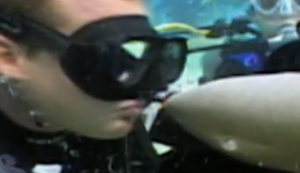 This guy tried to kiss a shark (and has done so successfully many times). Many people in the Florida Keys are comfortable with aquatic critters. Nurse sharks have even been documented showing what looks like pleasure in affection. I dont’ think that means it’s a good idea to try to kiss them on the mouth. Divers sometimes forget that sharks are wild animals. Seriously, I respect this guys passion, but I don’t think it’s wise to try to kiss even the most tame sharks on the mouth. You had it coming bro.
This guy tried to kiss a shark (and has done so successfully many times). Many people in the Florida Keys are comfortable with aquatic critters. Nurse sharks have even been documented showing what looks like pleasure in affection. I dont’ think that means it’s a good idea to try to kiss them on the mouth. Divers sometimes forget that sharks are wild animals. Seriously, I respect this guys passion, but I don’t think it’s wise to try to kiss even the most tame sharks on the mouth. You had it coming bro.
4. You’re more likely getting bitten by a person in NYC (than by a shark).
 That’s right – hundreds of times more likely actually. Let’s not even start talking about what you could catch on the subway, or the odds of being hurt while driving in that wonderful city – it won’t stop me from visiting, if only for a slice of pizza. It’s good to know the odds though. I think I’ll spend more time in the ocean. Fortunately, I know the relative risks of shark bites, and know that I’m also more likely to get hit by lightning, or bitten by a dog, or even a squirrel.
That’s right – hundreds of times more likely actually. Let’s not even start talking about what you could catch on the subway, or the odds of being hurt while driving in that wonderful city – it won’t stop me from visiting, if only for a slice of pizza. It’s good to know the odds though. I think I’ll spend more time in the ocean. Fortunately, I know the relative risks of shark bites, and know that I’m also more likely to get hit by lightning, or bitten by a dog, or even a squirrel.
5. Manny Puig and Sharkman ride “dangerous” sharks by their fins
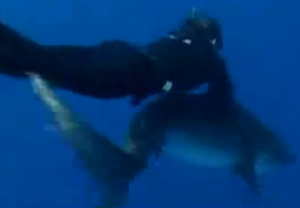
Watch Manny Puig – ultimate predator (preview – full movie available on netflix) ride a hammerhead, or rile up bull sharks with pole speared fish, or watch the Sharkman ride a great white.
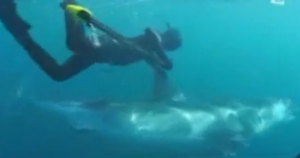
6. Even bullsharks in very active rivers don’t bite people
Bullsharks have adapted to swim hundreds of miles in freshwater, and are active in many places where people still used rivers for survival. Jeremy Wade of River Monsters went fishing for them miles upriver in the same waters people swim and play daily. While the video tries to be scary and dramatic – it just shows that bullsharks actively pursue fish, and not people.
7. You understand the Anatomy of a Shark Attack, (which sharks attack and why)
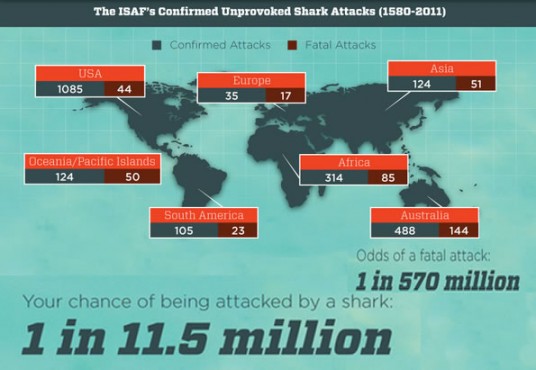 If you know where most of the bites happen, you will significantly decrease the likelihood you’ll get bit – that, or at least you’ll know it’s time to get out of the water when a shark bumps you. Around 4,000 sharkbites have ever been recorded since the year 1580 by the ISAF. This makes your odds of a shark bite around 1 in 11M, and 1 in 570M for a fatal attack. Chances are you’re safer in the water than in most places. In over 400 years – that’s an average about 10 cases per year. Also checkout How and Where Sharks Attack.
If you know where most of the bites happen, you will significantly decrease the likelihood you’ll get bit – that, or at least you’ll know it’s time to get out of the water when a shark bumps you. Around 4,000 sharkbites have ever been recorded since the year 1580 by the ISAF. This makes your odds of a shark bite around 1 in 11M, and 1 in 570M for a fatal attack. Chances are you’re safer in the water than in most places. In over 400 years – that’s an average about 10 cases per year. Also checkout How and Where Sharks Attack.
8. Many of the big sharks are tagged and studied
The Tagging of Ocean Pacific Predators project has been tagging white sharks and other migratory predators for years. If you really want to see how they do it, check out the Shark Wranglers, who caught the world’s largest 18 foot great white shark, also rock a Contender Center Console to catch fish (just like we do)
You can even see where the great whites are currently with TOPP’s online or iphone app.
9. Most of the sharks are already gone!
Over 30 million sharks per year turn into shark fin soup. Shark populations are down over 90% from 1970
 More shark decline info at Save our Seas, and why it’s happening, or check out this great infographic on the status of the shark, and shark conservation(Did you know more than 8,000 sharks are killed per hour on average?).
More shark decline info at Save our Seas, and why it’s happening, or check out this great infographic on the status of the shark, and shark conservation(Did you know more than 8,000 sharks are killed per hour on average?).
10. The number 1 reason you shouldn’t be afraid of sharks is logic.
Most sharks are harmless, and important to the ocean ecosystem. Most bites are mistakes. Sharks are beautiful wild animals and
Statistically speaking, you should be much more food quality, germs, traffic, heart disease, cancer, and a slew of other terrible things (More on death rate and sharks from surfmeister). Most of us don’t want to know the most likely causes.
Personally, I’m much more terrified every time I drive from downtown Miami to Coconut Grove with ten thousand self absorbed road raging Type A commuters during rush hour in a city where nearly anyone can carry a handgun in their car, than I am diving in clear, calm waters where I know there are bull sharks around somewhere looking for an injured fish to feed on. If you’ve never saw a shark bite a fish, or caught a tiger shark on a boat, it will give you a true appreciation for the animal when you do. They’re really a beauty of nature, and not the villain of a horror movie.
In fact, you’re probably more likely to get crushed by a vending machine during your break at work after you watch an hour of incredible shark footage at your desk, than even seeing a shark in the water if you go swimming in the ocean. Get out and see a shark for real – they’re really breathtaking. In the meantime, here’s all the reasons you’re a wimp if you’re afraid of sharks, and why logic suggests you’re also really bad at math.
The odds a person will die from a vending machine accident in a year are 1 in 112,000,000, while the odds that a person will die from a shark attack in a year are 1 in 251,800,000. While dying by vending machine seems rather absurd, many people are afraid of the water because of sharks, and you’re more than twice as likely to have a machine fall over on you while buying your daily doritos than you are having a shark bite you while swimming in the open ocean.
Of Hundreds of MILLIONS of people who get in the ocean every year, there are almost none that encounter sharks. Even if you’re lucky enough to see a shark big enough to bite you, you’re much more likely to have a heart attack than you are to even get bit by the shark.
I think sharks are awesome though, if you want to see them first hand try Hawaii Shark Encounters – they do a great job. I went twice and loved it.
For you more academic types, Checkout Guy Harvey and friends teaching you about sharks in This is Your Ocean documentary for more information on species and their feeding patterns. Really a great thing to watch on the beauty of sharks, and their behavior, and prepare you for a closer encounter.
We love sharks here at Mamifishing.com – and always practice catch and release of sharks. They are a powerful and worthy sportfishing adversary, and we love seeing them swim another day here aboard the Marauder.
If you made it this far – you must really like sharks as well – share this with a friend, enjoy shark week, and get out there and see one! Don’t let John Williams ruin the joy of the ocean for generations more to come. We all hear the music – just ignore it, and enjoy your swim 🙂
Here’s to swimming with bow legged women!
